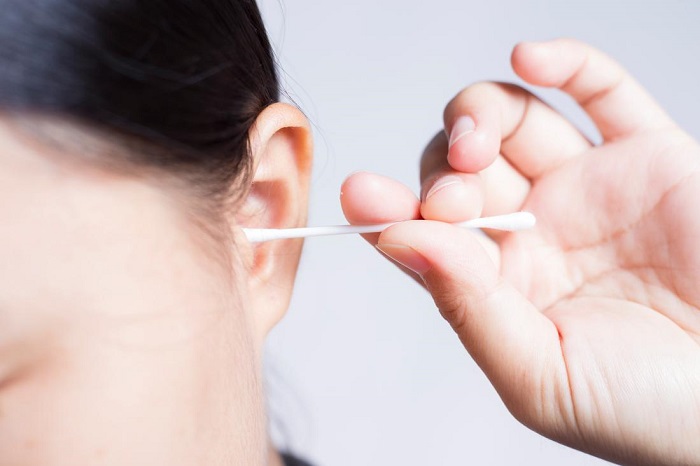Also, the skin of the ear canal is ultra-thin, and easily injured by just about anything you put in there. “If skin is broken, it can get infected and lead to a painful external ear infection—swimmer’s ear, in lay terms,” Dr. Chernobilsky adds.
If you want to keep your ears in perfect shape, he recommends ditching the following habits ASAP.
Attempting to clean regularly
Most people actually never need to clean their ears. “Ears are self-cleaning,” Dr. Chernobilsky explains. “It is the only part of the body in which the skin grows in a direction, and brings the wax and skin debris out from the canal to the outer ear.” (When you move your jaw and chew, you’re assisting this process.) Some people have more earwax than others, but in general, the ears make the amount of wax they need. The yellow-orange substance—technically known as cerumen—protects the skin in the ear canal by lubricating it and preventing it from filling up with water.
“It’s a natural skin lotion,” Dr. Chernobilsky says. “Cerumen also has properties which kill certain types of bacteria and prevent the growth of fungus.” So instead of digging for treasure in your ear canals, wait for the wax to loosen on its own and reach the outer ear. Then gently brush it out with a wash cloth.
Inserting cotton swabs
Cotton swabs are bathroom staples, but they’re not meant for use in the ears. It even says so on most packaging. The rigid, pointy shape can damage the skin, eardrum, and ossicles. Swabs can also push the wax in deeper and cause impaction, Dr. Chernobilsky says. One more unpleasant possibility: the cotton head can pop off in your ear canal. If that happens, you need to see a doc to have it removed.
Inserting any pointy objects
“People will stick just about anything they can think of into their ears when they feel discomfort—their long finger nails, bobby pins, sewing needles, keys, to name a few.” Anything sharp or shaped similarly to a cotton swab will pose the same risks of cutting the skin and damaging the inner and outer ear.
Candling
This practice involves placing a hollow, cone-shaped candle into the ear. The heat of the flame supposedly creates a vacuum effect, drawing wax to the candle. While some folks have anecdotal tales of success with candling, research has shown it’s bunk, and Dr. Chernobilsky considers it extremely dangerous: “I have seen eardrum perforations and burns from people’s hair catching on fire.” Yep, we’ll pass!
Rinsing with a syringe
“While this method is generally safe if done right, you are doing it blindly, and you can get a swimmer’s ear if the ear isn’t dried properly when you are done,” Dr. Chernobilsky says. In short: Your ears are not the place to build your own irrigation system.
Is there a safe way to remove wax?
Your best bet when it comes to earwax: Let it be.
But certain people may accumulate wax faster, Dr. Chernobilsky explains. “These are the people that use hearing aids with in-the-ear molds, doctors that use stethoscopes, musicians that use ear plugs, or people that use ear buds to listen to music, to name a few.” If your wax buildup really bothers you, visit your primary care provider or an otolaryngologist every few months to have your ears cleaned out.
Between those doctor visits, you can try an over-the-counter wax softener, as long as you know that your ears are otherwise healthy and you don’t have any cuts in or around the eardrum. Softening products typically involve drops or an oily solution that loosen wax and help it slide to the outer ear. Some products also come with peroxide to dissolve the stuff. “The [softeners] that are oil-based are just fine,” says Dr. Chernobilsky. But if you use a product with peroxide and have a cut, it will burn.
He also warns that if you’ve got a large plug of wax, a softener could make you feel much worse: “The peroxide can cause the wax to expand and cause significant pain, pressure, and hearing loss without dissolving the plug.”
Another trick you can try between doctor visits: Tilt your head to the side and put a few drops of mineral oil in the ear. “I prefer mineral oil to baby oil since it is inert and does not have any fragrances that people with allergies or sensitive skin may react to,” says Dr. Chernobilsky. Then lay your head on a towel-covered pillow for a few minutes, and the wax should slip out.
However, he cautions, this isn’t a solution for a major wax impaction. For that, you still need an MD.
More about:
















































